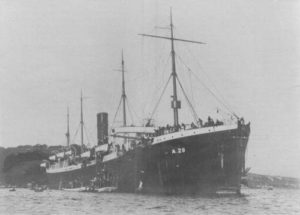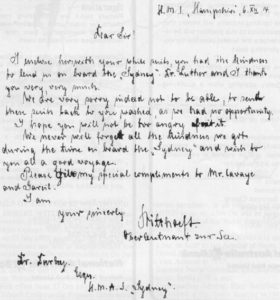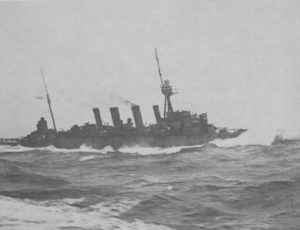The above interesting photo of the troopship S.S. SUEVIC, which appears to have been taken in SydneyHarbour, was held by George Hancock, formerly of SydneyHigh School and who was probably ...
WWI operations
The Birth of the Soviet Fleet, Kronstadt, 1921
Lost Letter Throws New Light on Sydney-Emden Action
Sydney – Emden Action: a short history
IN OCTOBER 1914, Sydney and her sister ship Melbourne detached from the Flagship (Australia) and returned to Australia to form a unit of the escort of the first Anzac convoy ...
Royal Australian Naval Operations 1914
I FEEL THAT THE 75TH ANNIVERSARY of the Royal Australian Navy should not be allowed to slip away without brief mention of the operations carried out by the Navy in ...
The Day the Emden Came A-Calling
(Reprinted by permission of Penang New Sunday Times, October 28, 1984) On October 28, 1914 – exactly 70 years ago today – most of the people of Penang were still ...
The Last Man on Anzac
THE HONOUR OF BEING THE LAST MAN on Anzac in 1915 seems to go to a naval rating, now living in Sydney. His name is Charlie Hooper, and this year ...
Coastal Motor Boats – 1916
In the early summer of 1915 three young Naval Officers from the Harwich Destroyer Force (Lieutenants Hampden, Bremner and Anson) conceived the idea of a small fast motor boat, capable ...
The Submarine AE2 in World War One
South of Gallipoli
In our September, 1976 issue we featured an article entitled ‘North of Gallipoli’ in which the author, Commander George Nekrasov, wrote of the relatively unknown operations of the Russian Black ...
North of Gallipoli – Black Sea 1914-1917
HMAS Cape Leeuwin
HMAS Sydney in the North Sea
The four photographs in this series are from the collection of Rear Admiral G. B. Moore, C.B.E. HMAS SYDNEY operated in the North Sea in the last years of World ...
Australian Naval History on 6 January 1916
The RAN Bridging Train was commended by General Bland, (British Army), for its tireless efforts before and during the evacuation of the Gallipoli Peninsular. The Commanding Officer of the RANBT ...
Australian Naval History on 20 December 1915
The last personnel of the RAN Bridging Train, (RANBT), left Suvla Bay at 0430 making them the last Australians to depart the Gallipoli Peninsula. A 50-man team under SBLT C. ...
Australian Naval History on 16 December 1915
The first contingent of three officers and 153 men of the RAN Bridging Train were evacuated from Gallipoli. ...
Australian Naval History on 16 November 1915
‘These men’, wrote CMDR L. S. Bracegirdle, RN, commanding the RAN Bridging Train at Gallipoli, ‘took pride in the fact they were the only Australian naval unit serving in the ...
Australian Naval History on 10 November 1915
The RAN Bridging Train commenced the removal of stores from Gallipoli in preparation for the evacuation. ...
Australian Naval History on 1 October 1915
The RAN Bridging Train was heavily shelled and bombed at Suvla Bay, Gallipoli. ...
Australian Naval History on 6 September 1915
The RANBT suffered its second fatality in two days of heavy shelling, at Suvla Bay, Gallipoli Peninsula. CPO E. C. Perkins was killed, and later buried in Hill 10 Cemetery ...
Australian Naval History on 21 August 1915
The RAN Bridging Train was engaged in salvaging torpedo boats, barges and small craft wrecked during a fierce storm which struck the beaches of Gallipoli. ...
Australian Naval History on 7 August 1915
The RAN Bridging Train landed at Suvla Bay, Gallipoli. The force was used in building wharves and pontoons, and unloading supply ships. ...
Australian Naval History on 25 July 1915
Transfer of the RAN Bridging Train for service with the Army on Gallipoli was approved by the Admiralty. The train handled the building of jetties and berthing facilities, and the ...
Australian Naval History on 3 June 1915
The RAN Bridging Train, (formed from members of the RAN Naval reserve), were embarked on the PORT MACQUARIE, for service in Gallipoli. ...
Australian Naval History on 25 April 1915
The submarine HMAS AE2, (LCDR H. Stoker, RN), penetrated the Dardanelles while the first ANZAC troops were storming ashore at Gallipoli. After evading Turkish warships and mines, she broke through ...






